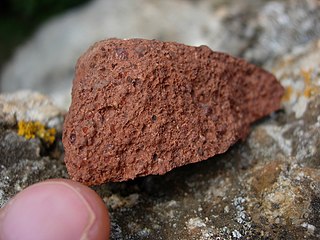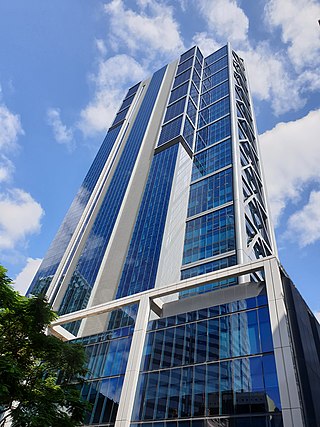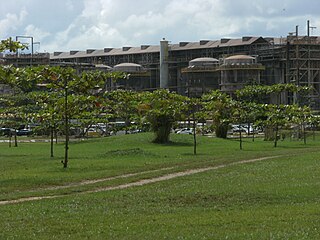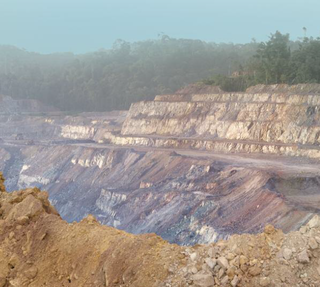
Bauxite is a sedimentary rock with a relatively high aluminium content. It is the world's main source of aluminium and gallium. Bauxite consists mostly of the aluminium minerals gibbsite, boehmite and diaspore, mixed with the two iron oxides goethite and haematite, the aluminium clay mineral kaolinite and small amounts of anatase and ilmenite . Bauxite appears dull in luster and is reddish-brown, white, or tan.

Suriname, officially the Republic of Suriname, is a country in northern South America, sometimes considered part of the Caribbean and the West Indies. Suriname is a developing country with a medium level of human development; its economy is heavily dependent on its abundant natural resources, namely bauxite, gold, petroleum, and agricultural products. Suriname is a member of the Caribbean Community (CARICOM), the United Nations, and the Organisation of Islamic Cooperation.
The economy of Suriname was largely dependent upon the exports of aluminium oxide and small amounts of aluminium produced from bauxite mined in the country. However, after the departure of Alcoa, the economy depended on the exports of crude oil and gold. Suriname was ranked the 124th safest investment destination in the world in the March 2011 Euromoney Country Risk rankings.

BHP Group Limited, formerly known as BHP Billiton, is an Australian multinational mining and metals public company headquartered in Melbourne, Australia.

WMC Resources Limited was an Australian diversified mining company.

Moengo is a town in Suriname, located in the Marowijne district, between Paramaribo and the border town Albina on the Cottica River. Moengo is also a resort (municipality) in the district of Marowijne. Moengo was the capital of Marowijne District between 1932 and 1945. The current capital is Albina.

Paranam is a town in the Para District, Suriname. Paranam was created in 1938 for a bauxite factory. In 1965, an aluminium smelter was added. The factories closed down in 2017.

Apoera, also Apura, is a town in western Suriname. The village has a population of 777 people as of 2020. It is the final destination of the Southern East-West Link. 24 kilometres (15 mi) north-west on the other side of the Courantyne River lies the Guyanese village of Orealla. The village is home to the Lokono tribe, but has been westernized. Due to the influx of people of Guyana, the languages used are English, and Sranan Tongo. Dutch is rarely spoken and the native language has all but disappeared. According to the oral tradition, Apoera was founded around 1920 by the Gordon family.

Diplomatic relations between the United States and Suriname were established on 23 January 1976. Suriname has an embassy in Washington, D.C. since 1976, and a consulate in Miami. The United States had a consulate in Paramaribo since 25 November 1975, the date of independence which was upgraded to an embassy on 18 February 1976.
The mineral industry of Mozambique plays a significant role in the world's production of aluminium, beryllium, and tantalum. In 2006, Mozambique's share of the world's tantalum mine output amounted to 6%; beryllium, 5%; and aluminium, 2%. Other domestically significant mineral processing operations included cement and natural gas.

Kabalebo is a resort in Suriname, located in the Sipaliwini District. Its population at the 2012 census was 2,291.
The Bakhuis Mountains are a mountain range in central Suriname, spanning 110 kilometres. The mountain range form of the northern part of the Wilhelmina Mountains, and the mountains and its village were named after the Dutch explorer and Royal Dutch East Indies Army officer Louis August Bakhuis. The range lies in the Sipaliwini Savanna District of Suriname. The Bakhuys Airstrip is near the village.
Bakhuys is a village in the Kabalebo resort of the Sipaliwini District in Suriname. The village is located near the Bakhuis Mountains. Bakhuis is mainly known for its large bauxite mine which is exploited by Suralco. In 1995, the refinery had received a $120 million upgrade and extension. The village and mountain range have been named after Louis August Bakhuis who led a 1901 expedition into the area.
Operation Grasshopper was a project to look for natural resources in Suriname from the air. For this project, seven airstrips were constructed in the interior of Suriname from 1959 onward.

The Olympic Dam mine is a large poly-metallic underground mine located in South Australia, 550 km (340 mi) NNW of Adelaide. It is the fourth largest copper deposit and the largest known single deposit of uranium in the world. Copper is the largest contributor to total revenue, accounting for approximately 70% of the mine's revenue, with the remaining 25% from uranium, and around 5% from silver and gold. BHP has owned and operated the mine since 2005. The mine was previously owned by Western Mining Corporation. Since the 1970s environmentalists, traditional owners and others have campaigned against the mine, largely on the basis of its contribution to the nuclear cycle and its use of underground water.

South32 Limited is a mining and metals company headquartered in Perth, Western Australia. It was spun out of BHP Billiton on 18 May 2015. It is listed on the Australian Securities Exchange with secondary listings on the Johannesburg and London Stock Exchanges.

Onverdacht is a village in the resort of Zuid in the Para District of Suriname. Between 1941 and 2009, it was a bauxite mining town.

Franklin Edgar Essed was a Surinamese forest scientist and politician. He served as Minister of Development from 1958 until 1963, and 1969 until 1973. Essed initiated Operation Grasshopper which build airstrips in the interior to map natural resources.

The mineral industry of Suriname makes up a large proportion of the country's economy. In 1916, the Aluminium Company of America began mining bauxite in the then Dutch colony of Surinam which over time became Suriname's main export.
The 1983 Suriname bauxite strike was a general strike by bauxite miners in Suriname from December 1983 to February 1984. The strike was in protest of tax increases, following a series of murders that happened 3 years before.













